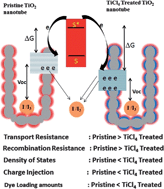Hydrothermally synthesized titania nanotubes as a promising electron transport medium in dye sensitized solar cells exhibiting a record efficiency of 7.6% for 1-D based devices
Abstract
Hydrothermally synthesized TiO2

* Corresponding authors
a
Institute of Fundamental Studies, Hantana Road, Kandy, Sri Lanka
E-mail:
jayasundera@yahoo.com
b NREL, 15013 Denver West Parkway, Golden, USA
c Sustainable Energy Technology, Department of Electrical Engineering, King Saud University, Riyadh, KSA
d Department of Chemistry, University of Peradeniya, Peradeniya, Sri Lanka
Hydrothermally synthesized TiO2

 Please wait while we load your content...
Something went wrong. Try again?
Please wait while we load your content...
Something went wrong. Try again?
J. Akilavasan, K. Wijeratne, H. Moutinho, M. Al-Jassim, A. R. M. Alamoud, R. M. G. Rajapakse and J. Bandara, J. Mater. Chem. A, 2013, 1, 5377 DOI: 10.1039/C3TA01576A
To request permission to reproduce material from this article, please go to the Copyright Clearance Center request page.
If you are an author contributing to an RSC publication, you do not need to request permission provided correct acknowledgement is given.
If you are the author of this article, you do not need to request permission to reproduce figures and diagrams provided correct acknowledgement is given. If you want to reproduce the whole article in a third-party publication (excluding your thesis/dissertation for which permission is not required) please go to the Copyright Clearance Center request page.
Read more about how to correctly acknowledge RSC content.
 Fetching data from CrossRef.
Fetching data from CrossRef.
This may take some time to load.
Loading related content
